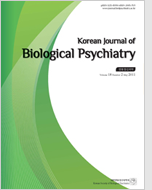
- Past Issues
- e-Submission
-

2021 Impact Factor 1.766
5-Year Impact Factor 1.674
Editorial Office
- +82-01-9989-7744
- kbiolpsychiatry@gmail.com
- https://www.biolpsychiatry.or.kr/

2021 Impact Factor 1.766
5-Year Impact Factor 1.674
Korean Journal of Biological Psychiatry 1996;3(2):216-21. Published online: Feb, 1, 1996
The quantitative EEGs of obsessive-compulsive disorder patients were analyzed using spectral analysis and compared to age and sex-matched controls. The subjects were 19 patients(men = 15, women = 4) suffering from obsessive-compulsive disorder(DSM-III-R). Absolute power, relative power and interhemispheric asymmetry of EEG were used to compare obsessive-compulsive disorder patients with controls. In order to fit the EEG data to a normal distribution, a log transformation of power values of every bandwidth in each deviation was calculated prior statistical analysis. The Wilcoxon rank test was performed to compare obsessive-compulsive group to the control group. In obsessive-compulsive disorder, abnormalities of quantitative EEGs are prominent in fronto-central. These results are compatible with other brain imaging studies of obsessive-compulsive disorder and suggested that fronto-central area plays an important role in the pathophysiology of obsessive-compulsive disorder.
Keywords QEEG;Obsessive-compulsive disorder;Spectral analysis;Frontal lobe.